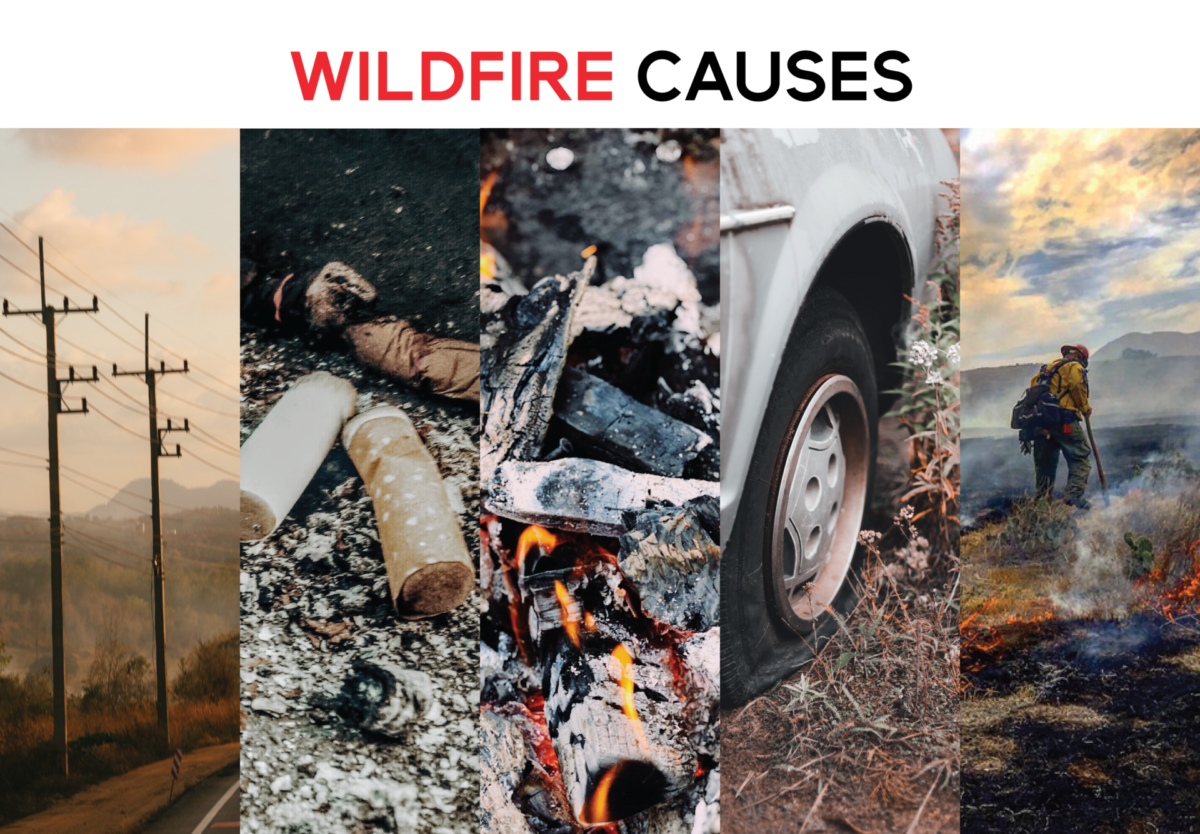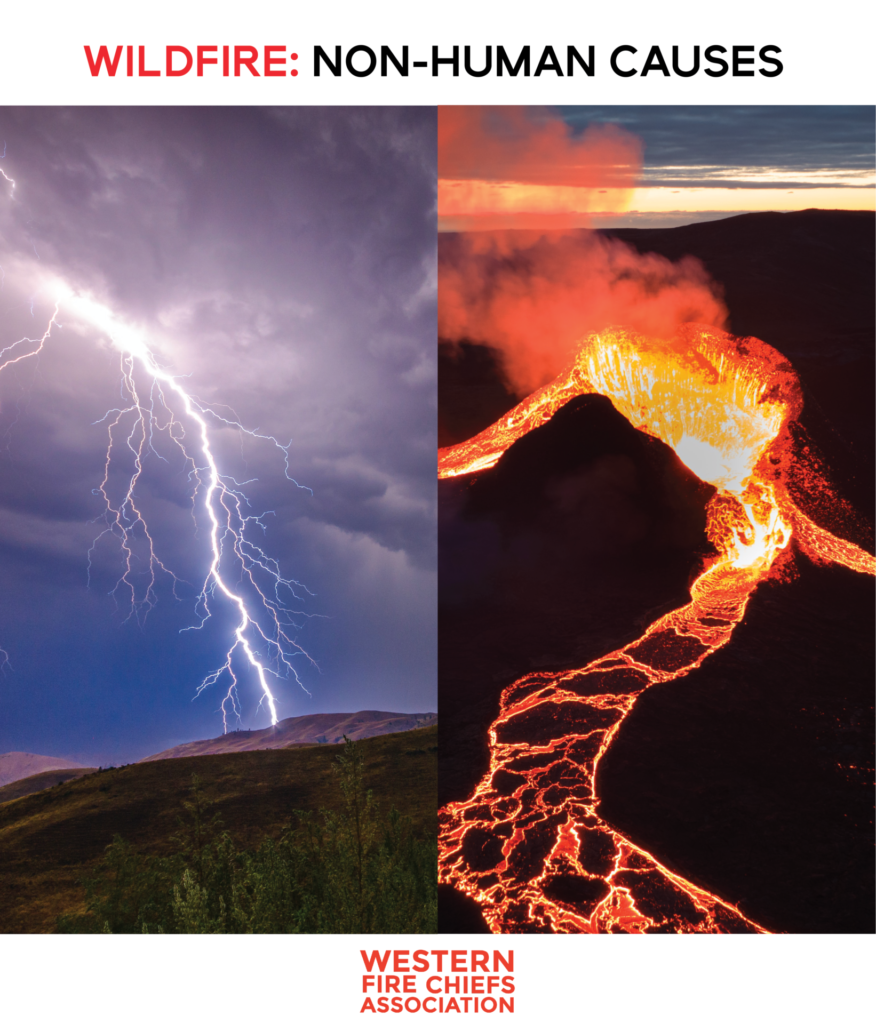Fire Pit Safety Tips
Stay safe around the campfire with tips from the Western Fire Chiefs Association. Learn essential precautions and practices for a worry-free outdoor campfire.
There are a variety of causes for wildfire, both human and non-human. Learn more about what causes wildfires with guidance from the Western Fire Chiefs Association (WFCA).
Published:July 5, 2022
Edited:March 4, 2024

Wildfires can start in numerous ways, originating from both human and non-human causes. Learn more about what causes wildfires with guidance from the Western Fire Chiefs Association (WFCA).
The necessary elements to start a fire are fuel, heat, and oxygen. Fuel is any kind of flammable material, including trees, grasses, and shrubs, but can also houses, patio decking, and garden furniture. Oxygen gas is already present in the air around us, which leaves heat as the final element.
Humans cause nearly 90% of wildfires in the United states1 via discarded cigarettes, unattended campfires, burning debris, or through equipment malfunctions. Although less common, wildfires can also occur though non-human phenomena, such as lightning strikes and volcanic eruptions. Read on to discover what causes wildfires.
Most human-caused fires are not started intentionally. Unfortunately, many human activities generate enough heat to start an uncontrolled fire.
Much of our existing infrastructure contributes to a higher quality of life for human beings. Unfortunately, it also poses a fire hazard if improperly maintained or when subjected to extreme weather. Electrical distribution systems are the most common cause of fire by equipment malfunction.
How to help prevent: Report downed power lines, malfunctioning electrical equipment, or suspected gas leaks to your local utility. Be sure to stay a safe distance away from any of these hazards. Where possible, take legislative action to support rigorous maintenance of infrastructure, and to make the switch to buried power lines.
A single cigarette butt carelessly discarded is all it can take to ignite and destroy thousands of hectares of land. In 2017, wildfires caused by cigarettes resulted in $6 billion in property damage.1
How to help prevent: Never discard cigarette butts on the ground. Always dispose of them in an appropriate, fire retardant receptacle.
Many people associate camping with happy memories. However, unattended campfires are one of the leading causes of wildfires when the proper steps are not taken to extinguish them safely.
How to help prevent: Always find a safe spot for a campfire, away from any unintended fuel sources like trees or houses, and protected from the wind. At the end of the night, take extra care to extinguish the fire completely. Pour water on the ashes until there is no more hissing and steaming. Use a shovel to move the ashes around within the burned area, and keep pouring water until no sparks remain.
Burning of debris or vegetation from yard clean-up is another leading cause of wildfires. Escaped embers from burn piles can carry for many miles without extinguishing on a windy day.
How to help prevent: In many states, burning yard waste is illegal. If you live in a state where it is permitted, check with your local fire department to determine when burning is allowed. Even on burn days, be sure to pay close attention to weather conditions, and take cautionary steps to burn debris safely. You can find more information about debris burning here.
Vehicles can spark fires in a number of ways. Some examples include: brakes worn too thin, hot exhaust pipes dragging in dry grass, driving on exposed wheel rims, or dragging chains. Any of these activities can generate sparks which could cause a fire.
How to help prevent: Make sure your vehicle is properly maintained by regularly checking the tire pressure, brakes, and ensuring nothing is dragging on the ground. Use appropriate safety pins and hitch ball when towing, and carry a fire extinguisher in your car.
For thousands of years, indigenous peoples have used fire to strategically shape the landscape. These intentional burns reduced flammable undergrowth, helped support natural processes, and cleared space for grazing meadows.3 Prescribed burning is still a viable way to pre-emptively combat largely destructive fires. However, decades of poor forest management and government-sanctioned fire suppression, in addition to climate change, can make prescribed burns harder to control in the present day. For these reasons, sanctioned burns sometimes turn into wildfires.
The other kind of intentional burn is arson, which is setting a fire on purpose for malicious reasons.
How to help prevent: Prescribed fire is a legitimate way to help prevent larger, more destructive fires, and has been used indigenous peoples for centuries. Express public support for forest management that incorporates scientifically and culturally informed prescribed fire.
Leave prescribed burning to the professionals, and do not set wildfires intentionally. Help to spread awareness of the dangers of wildfires and how to prevent them.
The majority of wildfires are started by humans, but there are two ways that wildfires can ignite independently.

Lightning is the most common non-human cause of wildfire. If lightning strikes, it can generate enough heat to ignite fuel sources, such as trees and shrubland. While lightning strikes cannot be prevented, the severity of fires caused this way can be reduced by appropriate land management activities.
Volcanic eruptions produce lava and ash which can ignite a fire. Steep, volcanic slopes can then lead to the fire spreading quickly.
Climate change continues to increase the number and severity of wildfires. By prolonging droughts and driving higher temperatures, climate change makes it easier for wildfires to start and spread, whether through human activity or other causes.
Stay safe around the campfire with tips from the Western Fire Chiefs Association. Learn essential precautions and practices for a worry-free outdoor campfire.
Discover essential firework safety tips to ensure a dazzling display without accidents. Learn how to celebrate responsibly with expert guidance from WFCA.
Explore the role of AI in wildfire prediction with guidance from the WFCA. Learn how advanced algorithms and data analytics enhance early detection and response.